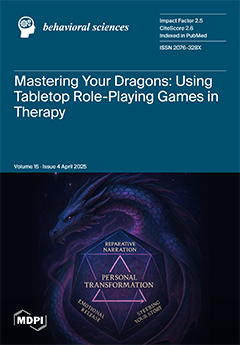Black/African American individuals experience high rates of posttraumatic stress disorder (PTSD), which is frequently chronic and undertreated in this population. Intimate relationships are a salient resource for Black/African American adults’ psychological well-being. To help advance health equity, this study serves as an initial,
[...] Read more.
Black/African American individuals experience high rates of posttraumatic stress disorder (PTSD), which is frequently chronic and undertreated in this population. Intimate relationships are a salient resource for Black/African American adults’ psychological well-being. To help advance health equity, this study serves as an initial, proof-of-concept investigation of patient outcomes among Black/African American adults who received a disorder-specific couple therapy for PTSD. Participants were a subsample of seven Black/African American adults (mean age = 40.56 years,
SD = 10.18; 85.7% male) who participated in an uncontrolled trial of an abbreviated, intensive, multi-couple group version of cognitive-behavioral conjoint therapy for PTSD with 24 military dyads. Treatment was delivered over 2 days in a weekend retreat format. Assessments were administered at baseline, 1 month post-retreat, and 3 months post-retreat. There were large and significant decreases in patients’ PTSD symptoms based on clinicians’ and patients’ ratings (
ds −1.37 and −1.36, respectively) by the 3-month follow-up relative to baseline. There were also large and significant decreases in patients’ depressive, anxiety, and anger symptoms (
ds −1.39 to −1.93) and a large, marginally significant decrease in patients’ insomnia (
d = −0.85;
p = 0.083). Patients reported a medium, non-significant increase in relationship satisfaction (
d = 0.68;
p = 0.146) and a large, marginally significant increase in joint dyadic coping (
d = 0.90;
p = 0.069). Findings offer preliminary evidence that treating PTSD within a couple context is a relevant strategy to reduce PTSD and comorbid symptoms among partnered Black/African American adults and a promising approach to enhance relationships.
Full article






